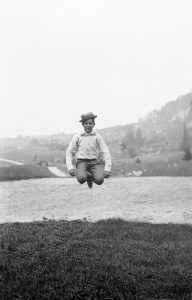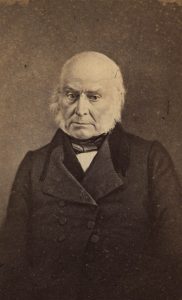By Heather Rockwood, Communications Associate
Photography is an interesting aspect of art history. Photographs capture real images the way we see them, sometimes even more clearly than the eye alone, or they can be manipulated for creative results using different shutter speeds, reprints from originals, experimentation with chemicals, and today, with Photoshop’s tools. Among the many photographs in the MHS collection, I am highlighting three examples that show photography’s versatility.
One special feature of photography is to create a plausible image from something impossible. For instance, in the image below a child appears to be happily sitting in midair—impossible! That magical impression is dismissed when we read the picture’s title, “Benjamin Sewall Blake Jumping.”

A second aspect of photography is more of a discovery for both the artist and his viewers. Francis Blake (25 December 1850‒20 January 1913) was a Massachusetts inventor who used his ingenuity to make the shutter speeds on his camera faster than most other cameras in the 1880s. With faster shutter speeds requiring less time to take a picture, he could snap people and animals in motion and with clarity. Only one other photographer preceded him in this new advance— Eadweard Muybridge (9 April 1830‒8 May 1904) in England. Between 1878 and 1886, Muybridge took photographs with fast shutter speeds and used emulsifying chemicals that made the images clearer in the printing process. His photography debunked a common belief that horses had a “flying gallop” or a flying superman-like spread of their front and back legs in opposite directions. Instead, his photographs showed that when horses are running and all legs are off the ground, their legs are below them and not spread eagle. Blake knew about Muybridge’s discovery and increased his own shutter speeds in 1888. Muybridge learned about Blake’s work and praised it.

The last special characteristic of photography is how decades and centuries later we can connect people outside what we think of today as their historical time. The MHS has an excellent example: John Quincy Adams. This image was printed on paper, but originates from a daguerreotype, which is the earliest form of photography, invented by Louis Daguerre in 1836. By 1839, daguerreotypes were being used worldwide. They were printed on metal and are a positive and negative image at the same time. The Adams image in the MHS collection was taken in 1847, a year before Adams died, and at a time when photography was sweeping the world in popularity. John Quincy Adams may be famously known for his time as President of the United States, 1825–1829, or for accompanying his father, John Adams, to Europe as a young man in the 18th century, but most people today probably overlook his later congressional career in the 1840s, when this image was taken, or realize the print in the MHS collection was created later, in the 1860s.

If you are interested in reading more, you can read an earlier post about how photographs are processed as MHS collection items here and explore a selection of photographs from our collection here.

